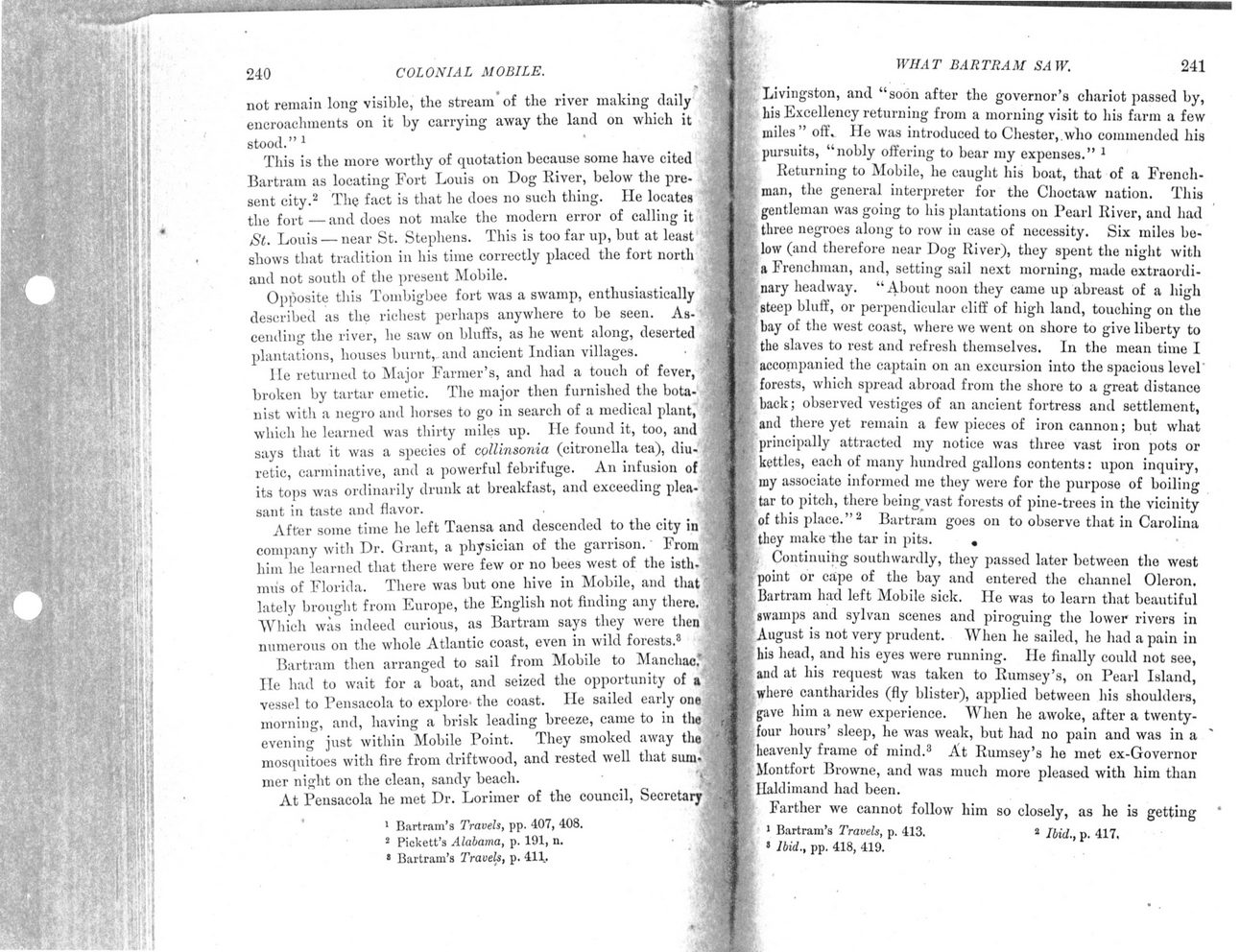This text was obtained via automated optical character recognition.
It has not been edited and may therefore contain several errors.
240 COLONIAL MOBILE. not remain long visible, the stream of the river making daily encroachments on it by carrying away the land on which it stood.?1 This is the more worthy of quotation because some have cited f. Bartram as locating Fort Louis on Dog River, below the pre- '4-sent city.2 The fact is that he does no such thing. He locates the fort ? and does not make the modern error of calling it ? St. Louis ? near St. Stephens. This is too far up, but at leant ?C shows that tradition in his time correctly placed the fort north and not south of the present Mobile. Opposite this Tombigbee fort was a swamp, enthusiastically gT described as the richest perhaps anywhere to be seen. As- *=*, cending the river, he saw on bluffs, as he went along, deserted ? plantations, houses burnt, and ancient Indian villages. ? He returned to Major Fanner?s, and had a touch of fever, broken by tartar emetic. The major then furnished the bota- \ nist with a negro and horses to go in search of a medical plant," which he learned was thirty miles up. lie found it, too, and J' says that it was a species of collinsonia (citronella tea), diu-retie, carminative, and a powerful febrifuge. An infusion of.f: its tops was ordinarily drunk at breakfast, and exceeding plea- f sant in taste and flavor. After some time he left Taensa and descended to the city in 4-company with Dr. Grant, a physician of the garrison. From 5 him he learned that there were few or no bees west of the isth-?v unis of Florida. There was but one hive in Mobile, and that gi'. lately brought from Europe, the English not finding any there. X Which was indeed curious, as Bartram says they were then \ numerous on the whole Atlantic coast, even in wild forests.8 & Bartram then arranged to sail from Mobile to Mancliac,*jjf lie had to wait for a boat, and seized the opportunity of a% vessel to Pensacola to explore- the coast. He sailed early one morning, and, having a brisk leading breeze, came to in tlie^i evening just within Mobile Point. They smoked away the ^' mosquitoes with fire from driftwood, and rested well that summer night on the clean, sandy beach. '*?_ At Pensacola he met Dr. Lorimer of the council, Secretary 1 Bartram?8 Travels, pp. 407, 408. s Pickett?s Alabama, p. 191, n. ? Bartram?s Travels, p. 411. ?? WHAT BARTRAM SAW. 241 Livingston, and ?soon after the governor?s chariot passed by, his Excellency returning from a morning visit to his farm a few miles? off. He was introduced to Chester, who commended hia 4 pursuits, ?nobly offering to bear my expenses.? 1 ' $' Returning to Mobile, he caught his boat, that of a French-?i'man, the general interpreter for the Choctaw nation. This ; gentleman was going to his plantations on Pearl River, and had > three negroes along to row in ease of necessity. Six miles be-i low (and therefore near Dog River), they spent the night with ?a Frenchman, and, setting sail next morning, made extraordinary headway. ?About noon they came up abreast of a high i steep bluff, or perpendicular cliff of high land, touching on the * bay of the west coast, where we went on shore to give liberty to it the slaves to rest and refresh themselves. In the mean time I ^accompanied the captain on an excursion into the spacious level f forests, which spread abroad from the shore to a great distance ^back; observed vestiges of an ancient fortress and settlement, | and there yet remain a few pieces of iron cannon; but what principally attracted my notice was three vast iron pots or "Ikettles, each of many hundred gallons contents: upon inquiry, % my associate informed me they were for the purpose of boiling tar to pitch, there being vast forests of pine-trees in the vicinity fof this place.?2 Bartram goes on to observe that in Carolina i they make the tar in pits. a % Continuing southwardly, they passed later between the west ?point or cape of the bay and entered the channel Oleron. 4 Bartram had left Mobile sick. He was to learn that beautiful |swamps .and sylvan scenes and piroguing the lower rivers in i August is not very prudent. When he sailed, he had a pain in ; his head, and his eyes were running. He finally could not see, ^ and at his request was taken to Rumsey?s, on Pearl Island, where cantharides (fly blister), applied between his shoulders, gave him a new experience. When he awoke, after a twenty-four hours? sleep, he was weak, but had no pain and was in a ?' heavenly frame of mind.3 At Rumsey?s he met ex-Governor Montfort Browne, and was much more pleased with him than Ilaldimand had been. Farther we cannot follow him so closely, as he is getting 1 Bartrain?s Travels, p. 413. 1 Ibid., p. 417. * Ibid., pp. 418, 419.

Bartram Colonial-Mobile-What-Bartram-Saw-p.-240-241